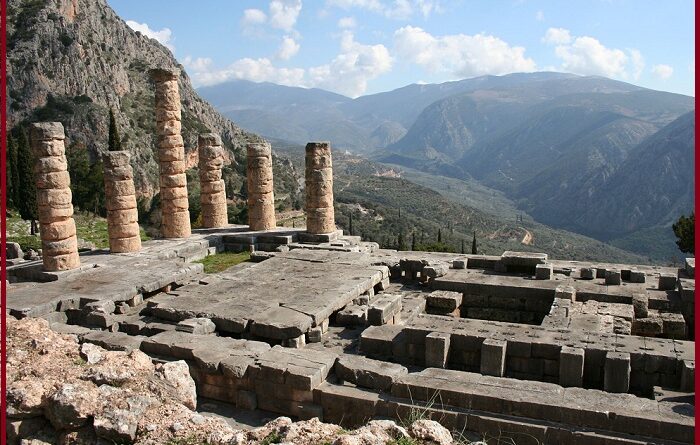‘The Temple of Appollo’ Delphi-A place of Hot talk among the Kingdom
The Temple of Apollo
The Temple of Apollo at Delphi is an ancient Greek temple. The temple is built at a strategic point midway up the sacred site on the southwestern slopes of Mt. Parnassus. An impressive amphitheater is tucked above the temple, into the natural crescent formed by the mountains. Still higher up, A very large ancient stadium located which is the site of the Pythian Games, Panhellenic competitions that were more important than the ancient Olympics in their days. Below Apollo’s Temple, A deep green river of millions of olive trees spreads and plunges from the mountains toward the sea.
The archaeological site of Delphi is about 160 km. northwest of Athens, above the Gulf of Corinth. It can be reached via the main route EO48. The Sanctuary of Apollo is above the road while the Sanctuary of Athena Pronaia sits below the road, which is equally impressive. The city of Delphi was named after the Oracle of Delphi, who supposedly foretold the future.
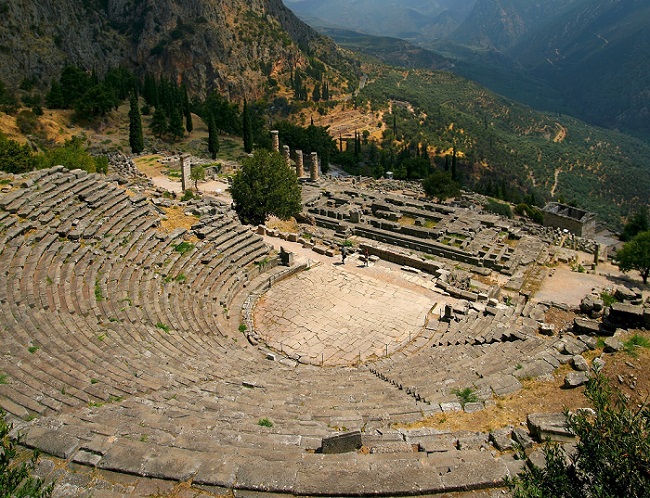
History The Temple of Appollo
The Greeks told many stories to explain the origins of Delphi. The site was originally sacred to Gaia, the ‘Mother Goddess’ whose cult centered on the Korykeon Cave, high on Mt Parnassos. After slaying a snake or she-dragon (known as Pytho) here, Apollo took the local name of Apollo Pythios.
Who was the Apollo
Apollo is one of the Olympian deities in classical Greek and Roman religion. The national divinity of the Greeks, Apollo has been recognized as a god of archery, music and dance, truth, healing and diseases, the Sun and light, poetry, and more. Apollo is one of the most important and complex of the Greek gods, he is the son of Zeus and Leto, and the twin brother of Artemis, the goddess of the hunt.
The height of Apollo’s temple fame came between the 6th and 4th centuries BCE, after the Amphictyonic League, a federation of 12 tribal states, took control of the sanctuary following the First Sacred War (595–586 BCE). As an autonomous state, Delphi earned great prosperity from benefactors including the kings of Lydia and Egypt, and the Roman emperor Hadrian.
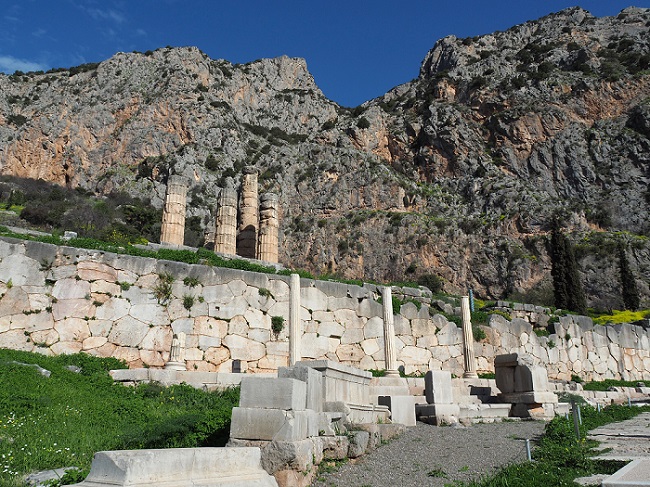
After surviving fire in 548 BCE and an earthquake in 373 BCE, the sanctuary was conquered by the Aetolians around 300 BCE, and by the Romans in 191 BCE. Although the Roman general Sulla attacked Delphi in 86 BCE, later emperors kept the oracle’s rituals alive well into the 2nd century. Ultimately its influence was sacked with the spread of Christianity, and the sanctuary was abolished by the Byzantine emperor Theodosius in the late 4th century.
Also read- The Secret of an Ancient Mesoamerican City-Teotihuacan
The Sacred Way, the path that climbs to the complex’s centerpiece Temple of Apollo, was lined in ancient times by treasuries and statues, erected by city-states including Athens and Sparta to thank Apollo and assert their own wealth and might. Some stand complete, and most lie in ruins, but together they form a magnificent spectacle.
Delphi has a natural site where the Temple of Apollo is built on a crescent-shaped mountain. The secluded and rugged site is shaped by the Korinth rift zone. Limestone and shale are common lithologies in mountains.
Attraction to the Temple of Appollo
In ancient times, visitors from various Greek and non-Greek cities brought tribute to Apollo through the Oracle. They built small temples, referred to today as treasuries, where their offerings were votive statues, gold and silver, wine, olive oil, and the spoils of war.
Temple of Apollo
The Temple of Apollo is the home of Apollo himself, dominating the entire sanctuary. It was built around the 4th century BCE, contained a statue of the god, guarded by an eternal flame, and was where the Pythia (oracle), the god’s mouthpiece, delivered her pronouncements.
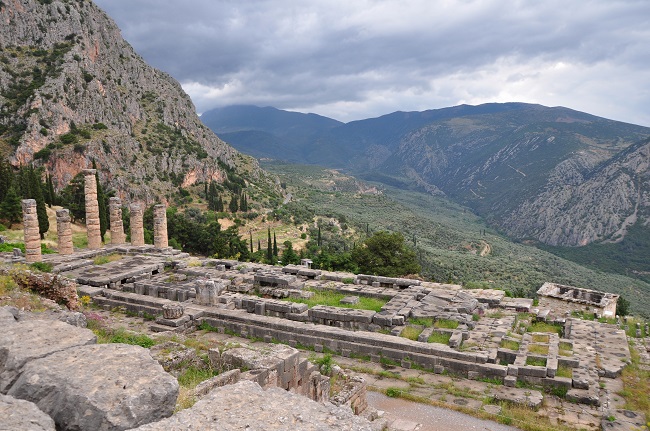
Treasury of the Athenians
The most impressive standing building along the path is the Treasury of the Athenians. It is a small Doric building of colorful Parian marble. So much of it was found in situ during excavations, now kept in an adjacent museum. This treasury was built in the 6th or early 5th century B.C. but there are conflicts in the stories. The more romantic theory is that it symbolized the victory of democracy over tyranny. Another story based on the writings of a 2nd-century Greco-Roman traveler and historian is that the treasury was built to commemorate the Athenian’s victory over the Persians at the Battle of Marathon.
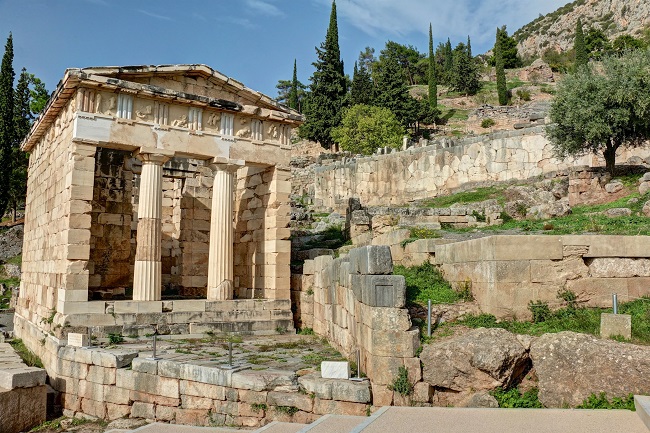
Ancient Theater of Delphi
About 160 meters further along the sacred way, is the Ancient Theater of Delphi. Musical events like singing and instrumental competitions were held here as part of the Pythian Games honoring Apollo as well as other religious festivals. The original theatre was built in the 4th century B.C. and was probably rebuilt during the second century B.C.
Ancient Stadium of Delphi
The Ancient Stadium of Delphi is located another 457 meters above the temple along the Sacred Way. It is the best-preserved monument where athletes first competed for the honor of Apollo’s crown of laurel leaves. it was built around the 5th century B.C. and later expanded by the Romans.
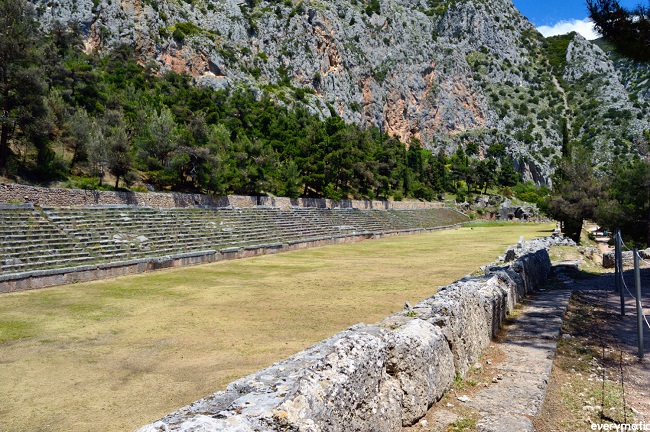
Sanctuary of Appollo at Delphi-Significance
In Ancient times many small kingdoms like- Athenians and the Spartans, the Siphnians, the Knidians, and other Hellenic states engaged in trade wars or hot wars, Delphi was the neutral, Panhellenic place where they could gather to conduct a negotiation, rituals, and deals. Leaders came here to consult the Oracle and then stayed to conduct diplomacy with each other. Gladiatorial games and theatrical performances were performed in this place to entertain the delegates.
How to reach the temple of Apollo Delphi
The distance between Athens and Delphi is around 190 kilometers. They run between 5 and 6 buses from Athens to Delphi every day. The modern town of Delphi is situated archaeological site of the same name and hence is a popular tourist and holiday destination.
